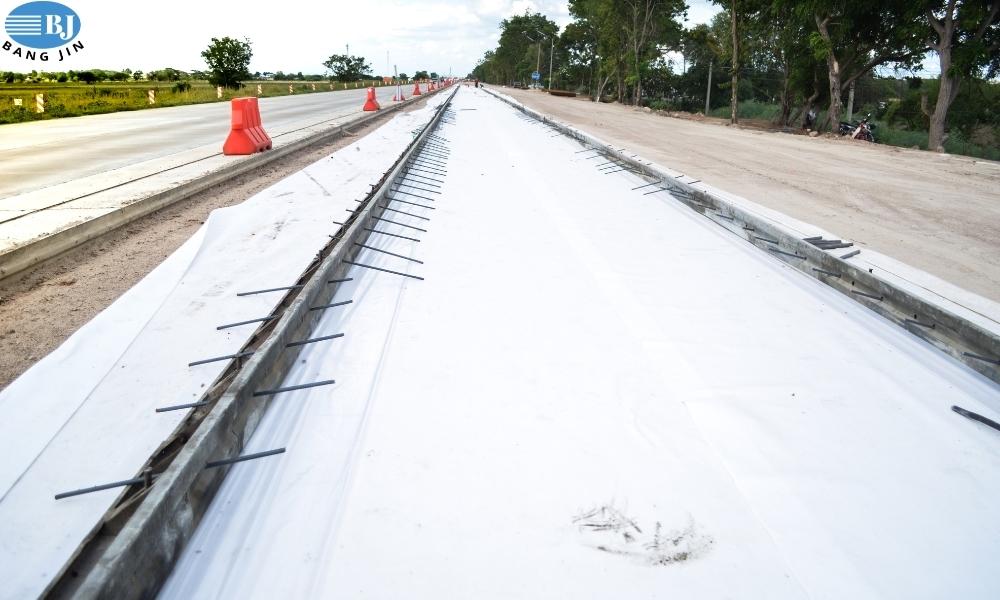Application of Nonwoven Geotextile Fabric is permeable geosynthetics constructed of nonwoven materials that are utilized in civil engineering projects alongside geotechnical materials (soil, rock, etc.). To construct a durable fibre network, it is made mechanically, chemically, or by heat-bonding fibres together.
Application of Nonwoven Geotextile Fabric is commonly composed of polymers such as polypropylene, polyethylene, polyamide, polyester, and other synthetic materials. Because of its low cost, low specific gravity, and strength, polypropylene dominates the geotextile market.
However, nonwoven geotextiles constructed of natural fibers are also available (jute, sisal, coir, etc). When utilized beneath the ground, this form of geotextile fabric is easy to cut, has a rising water permeability rate, and does not lose resilience over time like woven cloth does.
This makes it excellent for long-term ground stabilization and filtration underneath driveways and roadways, as well as in land and storm water drainage channels.
Benefits of Nonwoven Geotextile Fabric
Nonwoven Geotextile fabrics are made by gluing materials altogether rather than weaving them. This is accomplished by the use of chemicals or heat, as well as other techniques such as needle punching. These synthetic nonwoven textiles are commonly utilized for separating and filtering purposes.
Nonwoven textiles, despite their woven counterparts, are not as suitable for reinforcing and stabilization projects, but they are a better fit for unique applications like protecting geomembrane lining systems from outside or interior penetrations.
Nonwoven geotextiles, on the other hand, are a superior solution in the control of pooling or standing water difficulties. Nonwoven textiles, on the other hand, have outstanding durability and strength, as well as excellent drainage capabilities, making them appropriate for a wide range of applications.
Nonwoven geotextiles degrade significantly more quickly than woven geotextiles since they lack the reinforcing strength of many layers of material woven together.
Non-woven textiles, unlike their woven equivalents, are not as well suited to reinforcement and stabilization projects, while they are a superior alternative for certain applications such as protecting geomembrane lining systems from external or internal penetration rates.
Nonwoven textiles, on the other hand, have outstanding resilience and durability, as well as excellent drainage capabilities, making them appropriate for a wide range of purposes.
Application of NonWoven Geotextile Fabric

Geotextiles are made of continuous filaments or staple threads that are not knitted. For roads and railroads, off shore land reclamation, roadside, rail side, river and canal banks and embarkments, continuous filaments and staple fibres are utilized for separation, reinforcing, filtration, drainage, water resistance, and other applications.
Filtration, drainage, separation, strengthening, and erosion control are some of the distinctive functions of nonwoven geotextiles. The following are some examples of important functions:
Filtration
Nonwovens are employed to hold tiny dirt particles in place. This method avoids small grains from being seeped and components from escaping. It was created in the mid-1960s and is arguably the most widely used geotextile technology.
Separation
Nonwovens are used to divide two levels of soil with varying particle sizes. It aids in the prevention of fine-grained subgrade soils being pumped up onto permeable granular road bases. It prohibits a structure’s two neighboring layers from mingling. A nonwoven divider is required to guarantee the structure’s long-term functioning. Nonwovens are employed in geotextile with separation as its principal purpose in roads, railways, walls, dams, embarkments, obstacles, and other purposes.
Drainage
Geotextiles are utilized to transfer liquid or gas constituents as a passive element. The geotextile performs all of the drainage duties. However, it is frequently integrated with additional features such as drainage cores, perforation pipes, and so on.
To boost drainage system, needle-punched geotextiles are mixed with other materials. Drainage geo-composites are the result of this mixture.
Reinforcement
Geotextile is used as reinforcement in soft soils to boost their load-bearing capability. In the realm of road engineering, reinforcement is a prevalent use. The degree of tension in the underlying soil can be reduced by using nonwovens.
Since vertical loads activate horizontal shear strains. This nonwoven feature distributes the weight across a vast area and reduces its severity. The final goal is to decrease vertical stress and give fewer failure chances.
Liquid Barrier
The open nature of nonwoven geotextiles allows them to be soaked with clay fragments that penetrate open gaps within the geotextile’s design to prevent liquids from passing through.
Erosion Control
Nonwoven materials operate as a divider and a drainage layer, preventing erosion. However, it is classified as a special classification when its primary role is to help in erosion management. Soil depletion management is a significantly larger potential market for nonwoven geotextiles.
Roads, railroads, earthworks, retaining walls, sewer systems, erosion prevention, dams, canals, subterranean constructions, solid waste management, liquid waste containment, and other geotextile application areas are outlined by European standards. Nonwoven geotextiles can be used in a variety of applications, as shown in the list below:
- Separation of the roads
- Stabilization of the Highway
- Drainage Erosion Control (Temporary)
- Erosion Control That Is Permanent
- Protection for Geomembrane Liners
- Landfill Collection of Leachate
- Drainage Systems for Landfills
- Ventilation of Gas
- Drainage of Cow Carpet
- Filter Fabric Geo-Membrane Cushion by French Drains
- Railroad Ballast Separation using Landscape Fabric Pipe Wrap
- Under Pavers, Rip-Rap Separation
- Drainage of the Subsurface
- Trench Drains, Underdrains, and Weed Barriers, among other things.
Conclusion
The nonwoven geotextile industry has a unique environmental history. It has expanded to offer a wide range of engineered-fibre and polymer-based goods, all of which are fueled by low manufacturing costs, innovative, value-added processes, and so on.
With environmentally friendly geomaterials, the geotextiles business is reducing its reliance on low-cost labor. As a consequence, it has a lot of technology in common with vehicles, airplanes, computers, semi-conductors, and heavy machinery.
It is clear that using nonwovens in geotextiles will make the world a better place for future generations. As a result, the textile sector should do more research and invest in nonwoven geotextiles.

